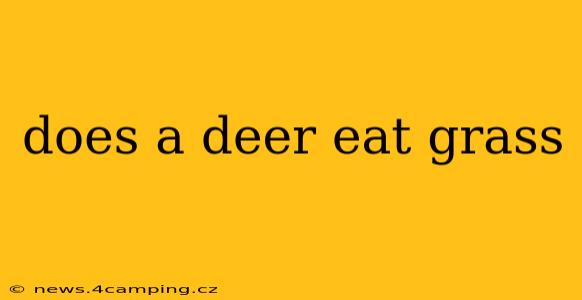Deer are herbivores, meaning their diet consists entirely of plant matter. While the image of a deer gracefully grazing in a meadow is common, the question of whether they only eat grass is more nuanced than a simple yes or no. Let's explore the complexities of a deer's diet and answer some frequently asked questions.
What Do Deer Primarily Eat?
Deer are browsers, meaning they selectively eat a variety of plants, rather than grazing like cows. While grass is part of their diet, it's not their primary food source. They prefer forbs (broad-leafed flowering plants), shrubs, and the tender shoots and leaves of trees and vines. The specific plants a deer consumes will depend heavily on the season and the availability of food in its habitat.
What Other Plants Do Deer Eat Besides Grass?
Deer are opportunistic eaters, adapting their diet to what's available. Here are some examples of plants commonly consumed by deer:
- Forbs: Clover, alfalfa, dandelion, thistle, and many other flowering plants.
- Shrubs: Sumac, blackberry bushes, oak brush, and huckleberry.
- Trees and Vines: Maple, oak, aspen leaves and twigs, Virginia creeper, and poison ivy (though they prefer other options if available).
- Fruits and Nuts: Acorns, berries, apples, pears, and other fruits when in season.
- Grasses: Various grasses, especially young, tender shoots. They will graze on grass but often prefer other plant matter.
Do Deer Eat Grass in Winter?
In winter, when other food sources are scarce, deer will rely more heavily on grasses and browse on twigs and buds of evergreen trees and shrubs. They may also dig through the snow to access dried grasses or other plant material. Their digestive systems are well-adapted to handle tougher, more fibrous plant matter during winter months, but they still prefer more nutritious options if available.
What are the Nutritional Needs of Deer?
Deer require a balanced diet to maintain their health and energy levels. This includes carbohydrates, proteins, fats, vitamins, and minerals. The specific proportions will change throughout the year, depending on their metabolic needs and the availability of different food sources. A lack of essential nutrients can lead to health problems and reduced fitness.
How Does a Deer's Diet Affect the Ecosystem?
Deer play a significant role in shaping their ecosystems. Their browsing habits can impact the abundance and diversity of plants. Overgrazing, particularly in areas with limited plant regeneration, can lead to habitat degradation. Understanding deer dietary habits is crucial for effective wildlife management and conservation efforts.
Are There Any Plants Deer Should Avoid?
While deer are remarkably adaptable, certain plants can be toxic or harmful to them. The specific plants vary by region, but some examples include:
- Poison ivy: Though deer sometimes eat it, they prefer to avoid it if other options are present.
- Oleander: Highly toxic to deer.
- Yew: Extremely toxic to deer.
- Azalea and Rhododendron: Contain toxins that can be harmful.
It's essential to remember that deer's dietary needs and preferences can vary based on location and season. This comprehensive look at their eating habits provides a better understanding of their ecological role and importance within their environment.
